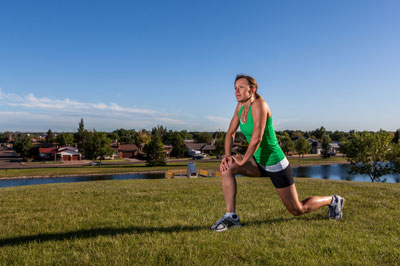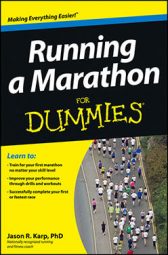Beginning with what time you get up to ensuring that you finish the race, there are many things you should definitely do on marathon race day. Following are just ten of the most important.

Give yourself plenty of time before the marathon
Even if you hate getting out of bed before the crack of dawn, you don’t want to wake up too close to the start time of a marathon.
Even if you’re running the Turtle Marathon in Roswell, New Mexico (the smallest marathon in the United States, with just 47 finishers in 2011), you still need to give yourself plenty of time the morning of the race to do everything you need to do — eat, drink, get dressed, drive to the start, go to the bathroom, warm up, stretch, and mentally prepare yourself.
So get up as early as you can, get food in you, and wake yourself up!
Eat breakfast
You’ve probably heard that breakfast is the most important meal of the day. If that’s so, then breakfast the morning of the marathon is as important as it gets.
Unlike shorter races, the marathon challenges your fuel reserves. When you wake up on race morning, your blood glucose is low because it’s been about 9 to 12 hours since you’ve eaten. Because carbohydrate is your muscles’ primary fuel when you run, you want to go to the starting line as full of carbohydrate as possible.
Wear familiar shoes and gear
Although you may be tempted to wear some fancy new kicks in the marathon, especially after all the miles you’ve put in on your old shoes, one of the biggest mistakes you can make on race day is to wear brand new shoes. Even if your new shoes are the same type of shoes you’ve been wearing, don’t wear them in the race.
If you’ve been training for a few months in the same shoes, you can buy new ones in preparation for the marathon, but buy them at least three weeks before the race and do at least one long run in them.
Although running shoes are your most important item, don’t wear anything new in the marathon. That goes for clothes — including your shirt or jersey, shorts, spandex, socks, underwear, and sports bra — as well as anything you plan to carry on you in the marathon, such as a fuel belt, water, and gels. Practice wearing your clothes and gear well before the race on your long runs so you get comfortable with everything.
Avoid cotton clothes
Cotton is one of the cheapest fabrics, but it’s also the least breathable. It holds your sweat rather than allowing it to evaporate. Don’t wear any cotton at all in the marathon. Wear lightweight fabrics that don’t stick to your skin. And listen to your mother and wear clean underwear; just make sure it’s not cotton.
Stay off your feet before the start
Twenty-six plus miles is long enough to run, don’t you think? The last thing you want to do before running the marathon is to run (or even walk) another couple miles. You only have so much carbohydrate fuel to go around. Save it for the race.
Consume carbs during the race
Most people have enough carbohydrate stored in their muscles and liver to last a little more than two hours of sustained activity. The best runners in the world can therefore run the entire marathon without consuming any carbs because they take just over two hours to complete the race. Everyone else needs to consume carbs during the race to maintain blood sugar levels and delay the depletion of carbohydrate.
Hydrate frequently
Hydration is very important because water is involved in the chemical reactions that enable your muscles to contract. Water also helps the flow of blood and oxygen to your muscles. If your body weight drops more than 2 to 3 percent during the race because of fluid loss, your pace slows down dramatically. Don’t let that happen. Start drinking early and often.
Pace yourself properly
Proper pacing is paramount for the marathon. If you start at a pace that’s too far over your head, it will come back to haunt you later in the race.
The most physiologically efficient (read: the least taxing) way to run a marathon is to run the first and second halves in the same time (or run the second half slightly faster than the first), with as little fluctuation in pace as possible throughout the race.
Finish the race
An injury or illness is the only circumstance under which giving up is okay. Don’t keep running if you’re putting your health at risk.
Every marathon has moments when the effort starts to feel uncomfortable. Backing off from physical discomfort for self-preservation is a natural human tendency, but one of the characteristics that makes runners unique is their penchant for seeking out discomfort. Hitting a rough patch in the race is when you learn about yourself and what you’re willing to do to meet your goal.
You want to walk away from your race feeling like you gave it everything you had. You want to be proud of yourself. So don’t give up. See the race to the finish, which is at the finish line.
Focus on your performance, not your time
Whether they want to qualify for Boston or break five hours, most runners go into the marathon thinking about a certain time they want to run. And most run slower than they want to.
Putting all your eggs in the time-means-everything basket is a great way to be disappointed if it doesn’t work out. Although it’s hard to run a marathon without some expectations, you’re much better off if you focus on your performance rather than the outcome. The time on the clock is an outcome. If you focus on your performance, you have a much better chance of getting the outcome you hope for.

